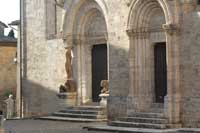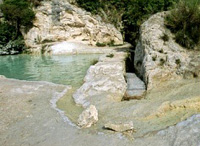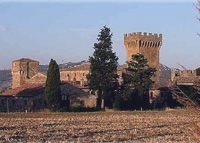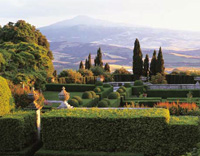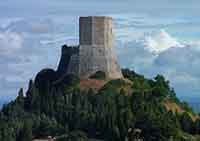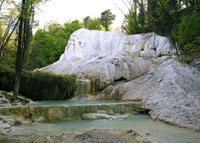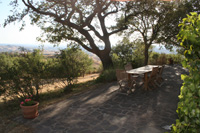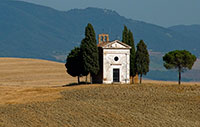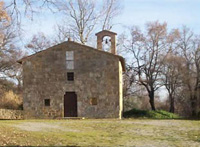Walking in Tuscany | Val d'Orcia
|
|||
The territory of the Val d'Orcia is made up, mainly of a hilly landscape with gently rolling hills and valleys typical of the Sienese Crete and a rich variety of vegetation. The river Orcia springs from a gorge and winds its way across the valley. |
|||
|
|
|||
Val d'Orcia | From the vineyards of Montalcino to the hills of Villa La Foce |
|||
This is a journey into harmony, down trails that seem to sail over ridges amidst cypresses, time-worn farmhouses and the geometric landscape. Wide-open spaces and unforgettable views accompany our ride through this worldly paradise up to Ghino di Tacco's stronghold. This unrivalledvantage point offers a breathtaking panorama over Terre di Siena, from Val d'Orcia to Monte Amiata and from the Crete to Monte Cetona. |
|||
Departure: the meeting of the Orcia and Asso waterways in the municipality of Montalcino Arrival: La Foce - Municipality of Chianciano Terme Distance: 28 km | Duration: about 5 hours |
|||
From San Quirico d'Orcia (the meeting of the Orcia and Asso waterways) to Bagno Vignoni | Distance 10,2 km |Duration: about 2 hours |
|||
This itinerary starts from the point where the Orcia and Asso waterways meet and travels through the enchanting Parco Artistico e Naturale della Val d'Orcia. The starting point can easily be reached from San Quirico d'Orcia. From the valley we climb up through woods and geometric fields toward the Podere Santa Barbara and Podere Caggiolo farmhouses, with ever more evocative views over the Orcia valley at its narrowest point. We then reach the fine Castello di Ripa d'Orcia which contributed to the defence of the Sienese Republic from the second half of the 13th century onwards. In 1438 Ripa d'Orcia became a definitive part of Siena's holdings. The castle is undoubtedly worth a stop and consists of an impressive square tower surrounded by a circuit of irregularly-shaped walls with a single entrance. From here we briefly climb toward San Quirico d'Orcia, walk around Ripa d'Orcia's cemetery and then descend toward the Orcia river opposite Podere Le Mulina. We pass through an old travertine marble quarry and reach Bagno Vignoni, one of the most scenic hot spring resorts in Terre di Siena. In spite of all the battles, attacks and fires that Val d'Orcia witnessed during the Middle Ages, this village has remained largely unchanged. Bagno Vignoni boasts one of Italy's most unique town squares. In fact, this liquid square is actually an impressive Medieval swimming pool filled with bubbling water that exits the spring at a temperature of 52 degrees.
|
|||
| Bagno Vignoni - La Foce | Distance 16,5 km | Duration about 4 hours |
|||
| The characteristic of Bagno Vigoni, besides the thermal waters, is its unchanged structure. From Bagno Vignoni we go down to the Via Cassia (Strada Statale 2) to again reach the course of the Orcia river. We follow the trails along the river and cross the Tresa stream not far from the Castello di Spedaletto, an interesting fortified village important in Medieval times as a rest stop for pilgrims travelling to Rome. Now we travel down an open valley along the Orcia river until we near where it meets the Formone river. Wide-open spaces facilitate our ride to the farms of Poggio Meriggi, Torricelle, Casalta and Casanova. At this point we go down one of the most famous and photgraphed roads in the province of Siena, lined with cypresses that delineate its curves. We then reach the Strada Provinciale that links Monte Amiata to Cianciano Terme. We walk around a number of old farms (Sant'Antonio, Fonte al Gozzo, Fonte Tetta) and finally reach the Fattoria della Foce, a graceful Renaissance residence whose classic Italian garden and antique rose bushes may be visited on appointment. From here we easily reach Chianciano Terme and Val di Chiana. The Castello di Spedaletto [Spedaletto Castle] |
|
||
Bagno Vignoni - Bagno Vignoni | Distance 9 km | Duration about 3 hours |
|||
| Bagni Vignoni derives its name from the 11th century castle that still towers over the village. The thermal baths are architecturally inviting with a porch-type bridge built over the water. This water is then transferred from the bath to the many thermal houses that line the village. The water then passes through mills located on the banks of the river.
|
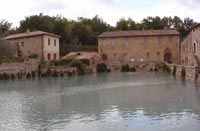 Bagno Vignoni boasts one of Italy's most unique town squares |
||
Itinerary in the great scenery of the Val d’Orcia. The hike from Bagno Vignoni to Rocca d’Orcia is absolutely stunning. The crossing of the Val d'Orcia follows the old Via Cassia for some short stretches but then climbs up to Rocca d’Orcia in a landscape that becomes increasingly wild and solitary.
There is a good, shorter alternative, avoiding the climb to Ripa d'Orcia and Rocca d'Orcia, folllowing the Orcia river instead.
|
|||
Castiglione d'Orcia - Castiglione d'Orcia |
|||
Situated in the middle of the Val D’Orcia, and above the river of the same name, the town is surrounded by a natural environment which has remained, on the whole, unchanged. The most important religious building of Castiglione d' Orcia is the church la Chiesa dei Santi Stefano e Degna with its façade from the 1500's. At the highest point in town, one can still see remains of the original city wall which opens upon a view of the mountain Monte Amiata and upon the fortress Rocca a Tentennano. The fortresses' imposing tower, recently restored, may also be visited when the fortress is open to the public. While there on its summit, enjoy the breathtaking 360 degree panorama from Siena to Radicofani, from Montalcino to Pienza and Montepulciano, and from Monte Amiata to Monte Cetona. Moving along past the Rocca a Tentennano, one enters into the village below called Rocca d' Orcia. Here worth a visit are the churches, the Pieve di San Simone, the Chiesa della Madonna delle Grazie di Manno, and the little main town square holding a cistern said to date back to 1262. In the large area covered by the municipality, many other towns also deserve a mention: first there is Bagni San Filippo, a place known for its spa waters which gush out water at a temperature of 52 degrees centigrade and which have deposited immense calcium deposits in the nearby Fosso Bianco (or White Ditch). Then there is Campiglia d'Orcia, featuring an unusual historical centre spreading out like a fan beneath a rocky ridge and from which rises a fortress built in the year 973. Ripa d' Orcia, on the right side of the river, has one of the most evocative castles in the valley. |
|||
Departure and Arrival: Castiglione d'Orcia Length: 11.5 km Road surface: dirt track and country road Height difference: ca. 400 m Duration: 3 hours on foot, 1 and a half hours by bicycle. |
|||
The itinerary starts on a downslope and ends uphill. From the hamlet of Castiglione d'Orcia we get to the bottom of the Orcia valley which is characterized by a wild environment where no means of transport are possible. It predominantly unfolds on dirt tracks. For the mountain bike enthusiasts it doesn't show any technical difficulties even though the downslope, specially in the first part, is very steep and the climbing back up is quite challenging. We leave from the centre of Castiglione d'Orcia, and precisely from Il Vecchietta square, getting into Via del Cassero uphill to Porta di Sopra. Once we're out of the village walls we climb down, on the right, toward the hamlet of Rocca d'Orcia. At the T junction, past the village, we turn left by the Tentennano rock. Past the San Simeone hotel we get onto the paved little road on the left which enters the centre of Rocca d'Orcia, in front of the little church of San Sebastiano and down to the Cisterna square. From here we follow the road downhill to the stone arch out of the hamlet. Once we are at the church we turn left on the asphalted road and left again at the next junction (ca. 50 m). From here, the view over the Val d'Orcia and Pienza is very beautiful. At a hairpin we follow directions to Podere Colombaiolo and Podere Le Moline. The road, downhill, becomes a dirt track and climbs down to the bottom of the Orcia valley. We now go through olive groves and farming fields close to the Podere Colombaiolo and then proceed through the thick vegetation prevalently of oak trees. The cart road, marked with red and white paint, steeply climbs down offering a stunning view over the old village of Vignoni and Bagno Vignoni. We keep now following the main road avoiding all the left and right turns. After about 1 km the road, keeping at the same height, faces the opposite versant of the Val d'Orcia. From Rocca d'Orcia, after 2.5 km we arrive at the Podere Le Moline. The white country road goes between the farmhouse on the right and three cypress trees on the left. Instead of proceeding on the road, past the cypresses, we turn left into a trail that skirts the farmhouse's young vineyard. At the end of it the trail carries on the right entering the thick bush. We walk now for a few minutes on the trail that, at a clearly visible hairpin, gets into a cart road which we will take on the right and downhill. After about 5 minutes we get to a junction where keeping the right we cross a small stream (dry in summer). We then go uphill to climb down again to another stream. Walking on the main trail we suggest to make a detour on the right to climb down to the wild valley floor where the river Orcia runs. From here we can enjoy a great view of the fortified hamlet of Ripa d'Orcia. We then climb back up on the same cart road for about 5 minutes. After a little while we get to a clearly visible hairpin going uphill (avoid the right turn) and carry on walking following the red and white marks on the trail that goes up the valley's slope. The uphill footpath ends in the proximity of the ruins of the Montelaccio farmhouse. Here, past the ruins, we carry on straight ahead on the path that, in the open, runs midway up the slope passing by an old spring. After 800 metres we arrive at the Scalceta Farmhouse and soon after we turn left at the junction on the uphill track. Beyond the hunting lodge called Il Leccino, next to an electric pole we turn left again and slightly uphill. After about 1 km we get to the Finocchieti farmhouse that overlooks the Mount Amiata on the side of Seggiano. Furher up the view also opens up on the left side (north) of the road over the hill of Montalcino. We proceed on the dirt road for about 1.5 km up to a junction where we turn left for the last part of the uphill slope toward Castiglione d'Orcia going through the most panoramic spot of the entire itinerary with great views over the Maremma, Amiata, the Cetona mountain and the Val d'Orcia. Back on the asphalted road we arrive at the highest spot of Castiglione d'Orcia from where we enjoy the view over the imposing Rocca of Tentennano. We enter the village through the Porta di Sopra which is very close to Piazza Il Vecchietta. |
|||
The province of Siena offers multiple choices for the lovers of vacations on bicycles; from Sunday riders to professionals, from road cyclists to mountain bikers, there is such an array to choose from that your head will spin. Apart from the series of daily routes which are in effect loop rides, in other words they begin and end in the same place, there is the possibiliy of creating itinerant routes which travel across the Sienese territory: the Tour of the Land of Siena and the route of the Eroica ralley. The daily routes can be chosen based on several different criteria, the level of training one has, the type of route prefered, the topography of the zone and its roads and the type of cycle one has. The two long routes, the Eorica and the Tour of the Land of Siena, offer the possibility of discovering the dimension of the slow trip along an ever changing countryside. |
|||
|
|||
A walk through Montepulciano
|
|||
Confined within its ancient city walls and bastions, Montepulciano is crossed by a long wide street called the Corso, the main street of Montepulciano. The Corso stretches for 11.5 kilometers from the Porta al Prato to the Piazza Grande at the top of the hill. The Sanctuary of the Madonna di San Biagio, outside the city was by Antonio da Sangallo the Younger between 1518 and 1545. It has a circular (central) plan with a large dome over a terrace and a squared tambour. The exterior, with two bell towers, is built in white travertine.
|
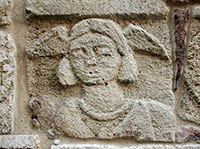 Outside the Bucelli Palace is an unusual foundation made up of tombstone fragments of Etruscan and Roman art |
||
Mappa Val d'Orcia | Ingrandire mappa |
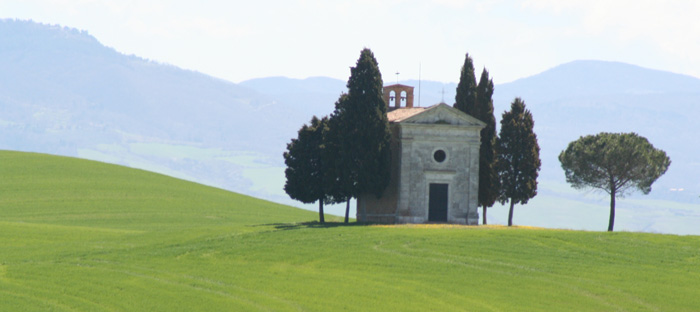 |
|
An exellent selection of hiking trails can be found on the website of Podere Santa Pia.
|
||||
Podere Santa Pia |
Podere Santa Pia |
Madonna di Vitaleta Chapel, San Quirico d'Orcia |
||
Pienza |
Pieve di Santa Maria dello Spino |
San Quirico d'Orcia |
||
|
||||
[1] Photo by Antonio Cinotti, published under a Attribution-NonCommercial-NoDerivs 2.0 Generic (CC BY-NC-ND 2.0) license. |
||||

